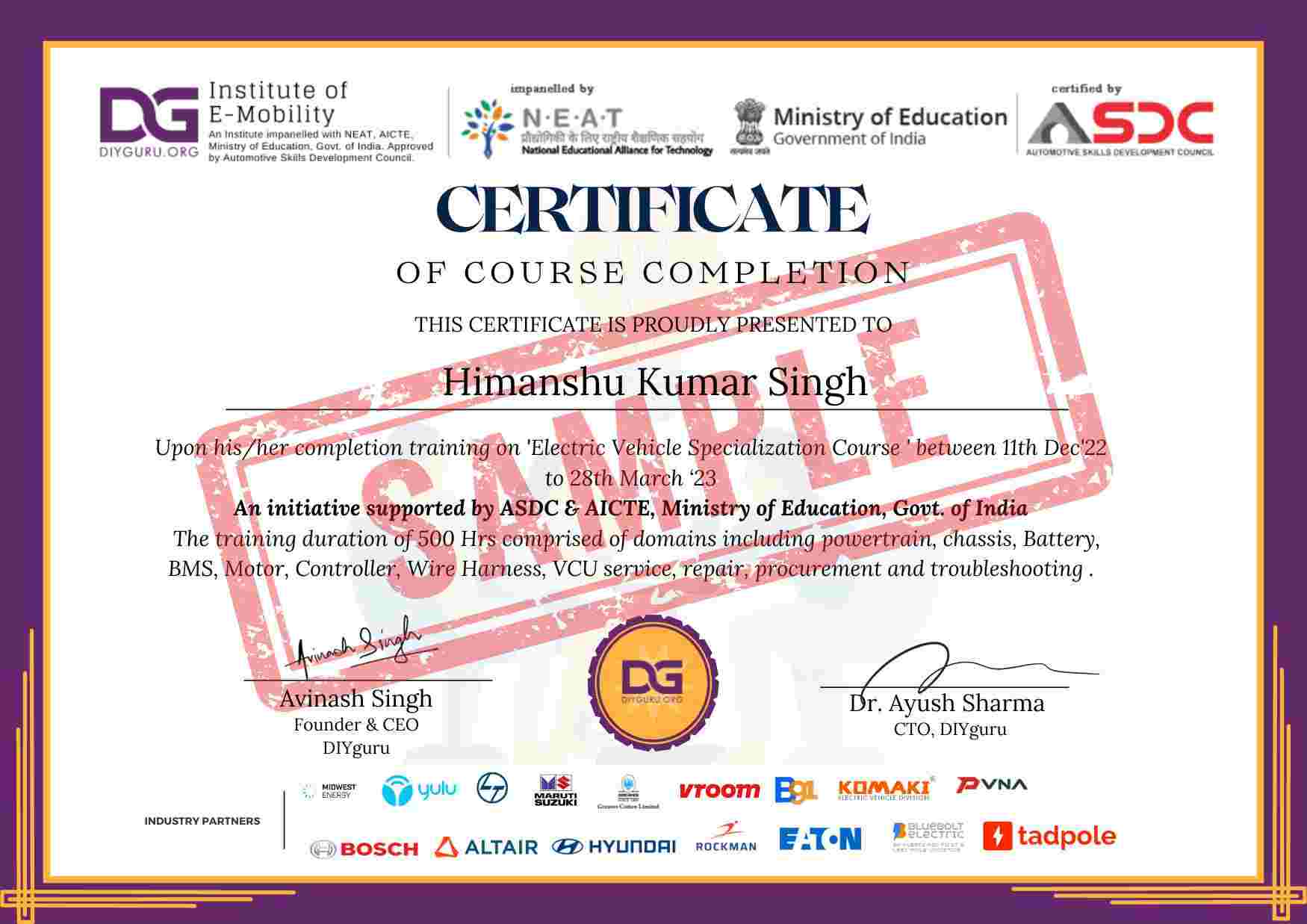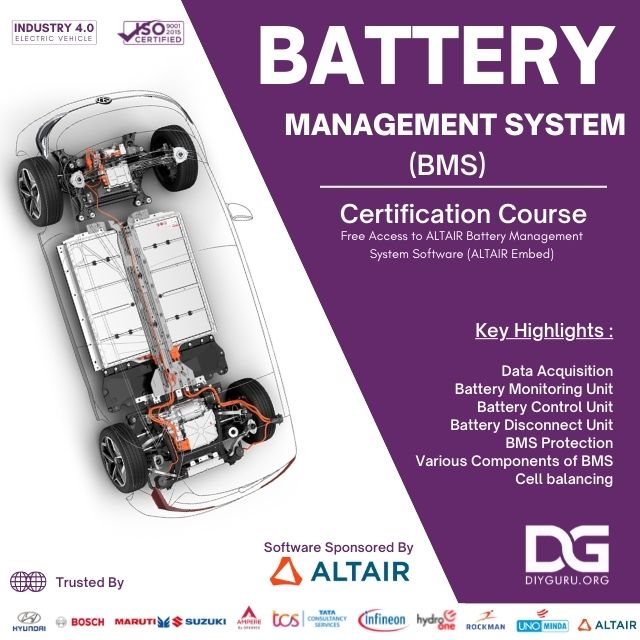BMS (Battery Management System) Course | Electric Vehicle
Program Fee:
₹7,500.00 ₹3,999.00
Need help in selecting the right program? Talk to our counselor!

Sample certificate
Global Verified Certificate
Certified by ASDC, Automotive Skills Development Council & NEAT, AICTE, All India Council for Technical Education, Govt. of India
The ongoing transformation of battery technology has prompted many newcomers to learn about designing battery management systems. This course provides a beginner’s guide to the battery management system (BMS) architecture, discusses the major functional blocks and explains the importance of each block to the battery management system.
In this course, we’ll take a look at Battery Management Systems and look at what a battery management system is, what it does and we’ll also explore the individual components that typically make up a battery management system.
A battery management system is essentially the “brain” of a battery pack; it measures and reports crucial information for the operation of the battery and also also protects the battery from damage in a wide range of operating conditions.
The single most important function that a battery management system performs is cell protection.
Lithium ion battery cells have two critical design issues; if you overcharge them you can damage them and cause overheating and even explosion or flame so it’s important to have a battery management system to provide overvoltage protection .
Lithium ion cells can also be damaged if they’re discharged below a certain threshold, approximately 5 percent of total capacity. If the cells are discharged below this threshold their capacity can become permanently reduced.
To ensure a battery’s charge doesn’t go above or below its limits, a battery management system has a safeguard device called a dedicated Lithium-ion protector
Every battery protection circuit has two electronic switches called “MOSFETs.” MOSFETs are semiconductors used to switch electronic signals on or off in a circuit.
A battery management system typically has a Discharge MOSFET and a Charge MOSFET.
If the protector detects that the voltage across the cells exceeds a certain limit, it will discontinue the charge by opening the Charge MOSFET chip. Once the charge has gone back down to a safe level then the switch will close again.
Similarly, when a cell drains to a certain voltage, the protector will cut off the discharge by opening the Discharge MOSFET.
The second most important function performed by a battery management system is energy management.
A good example of energy management is your laptop battery’s power meter. Most laptops today are not only able to tell you how much charge is left in the battery but also what your rate of consumption is and how much time you’ll have left to use the device before the battery needs to be recharged. So, in practical terms, energy management is very important in portable electronic devices.
The key to energy management is “Coulomb counting.” For example, if you have 5 people in a room and 2 people leave you’re left with three, if three more people enter you now have 6 people in the room. If the room has a capacity of 10 people, with 6 people inside it’s 60% full. A battery management system tracks this capacity. This state of charge is communicated to the user electronically through a digital bus called an SM BUS or through a state of charge display where you press a button and an LED display gives you an indication of the total charge in 20% increments.
Battery management systems for certain applications like the one for this hand-held point-of-sales terminal also include an embedded charger consisting of a control device, an inductor (which is an energy storage device), and a discharger. The control device manages the charging algorithm. For lithium-ion cells, the ideal charging algorithm is constant current and constant voltage.
A battery pack usually consists of several individual cells that work together in combination. Ideally, all the cells in a battery pack should be kept at the same state of charge. If the cells go out of balance, individual cells can get stressed and lead to premature charge termination and a reduction in the overall cycle life of the battery. The cell balancers of the battery management system, shown here, extend the life of the battery by preventing this imbalance of charge in individual cells from occurring.
Now that we’ve gone over the basic components of a battery management system and what they do, in the other videos in the series we delve deeper by looking at battery pack design for different applications, from large scale to small scale and we’ll also take a look at the unique design challenges a battery pack designer faces like available space, heat dissipation requirements and how form factor or “usability” of a device factors into battery pack design.
Battery Management Systems
Battery Management Systems are the brains behind battery packs. They manage the output, charging and discharging and provide notifications on the status of the battery pack. They also provide critical safeguards to protect the batteries from damage.
Learning Objectives
Upon completion of this online course, participants will be able to understand following BMS concepts:
- Definition and Classification of BMS
- BMS Functionalities
- Summarize the basic components and functionality of the Battery Management System
- Understand Battery Management System (BMS) components and function
- Discuss the factors that influence battery
- BMS Topologies
- Balancing systems
- Fuse and Switch Box
The primary job of a BMS is to protect the battery (by preventing operation of any cell outside its safe operating area)
• A secondary job may be to maximize the battery capacity (by balancing the battery’s SOC).
• Battery Management Systems (BMS) are used to manage a battery pack, such as by: • Monitoring its state • Calculating secondary data. This course will provide you with a firm foundation in lithium-ion cell terminology and function and in battery-management-system requirements as needed by the remainder of the specialization.
SYLLABUS:
Protection: Over voltage, Over current, Under voltage, Short circuit, Open circuit
✓Thermal management
✓Intelligent Cell Balancing
✓Health Monitoring
✓State of charge monitoring
✓Compatible with all Cell chemistries
✓Digital and Analog output controls
BMS means different things to different people. To some it is simply Battery Monitoring, keeping a check on the key operational parameters during charging and discharging such as voltages and currents and the battery internal and ambient temperature. The monitoring circuits would normally provide inputs to protection devices which would generate alarms or disconnect the battery from the load or charger should any of the parameters become out of limits.
For the power or plant engineer responsible for standby power who’s battery is the last line of defence against a power blackout or a telecommunications network outage BMS means Battery Management Systems. Such systems encompass not only the monitoring and protection of the battery but also methods for keeping it ready to deliver full power when called upon and methods for prolonging its life. This includes everything from controlling the charging regime to planned maintenance.
For the automotive engineer the Battery Management System is a component of a much more complex fast acting Energy Management System and must interface with other on board systems such as engine management, climate controls, communications and safety systems.
Learners love DIYguru
Here’s what some of our 40,000+ satisfied learners have to say about studying with DIYguru Team.

"Very informative course, high quality in terms of quizzes and assignments, liked the project at the end of the course. Oh, and great support. Can recommend this one to my friends and colleaugues. Being the very first player in EV industry, DIYguru has been crucial to the EV ecosystem development in india"

"I have known DIYguru since 2013 when the first version Autosports india was launched and in last 6-8 years the platform has emerged as the leading maker's learning platform in india. Form me the team behind DIYguru has been the best support all through the journey after Bachelors till my master's"

"Some of the best customer service I've ever seen. Great platform for mechanical and electrical engineers to learn EV!"

"This is truly a 5 star experience for youngsters in india! keen to learn about EV Technology"

"The platform has helped me personally to build my career in renewable energy in Canada. Hope to see DIYguru in Canada soon. Five stars!"

"liked the course with wide range of calculations in EV, all tutors are very supportive."

"Automotive design with incredible knowledgebase in terms of support from Baja Tutor community of DIYguru is wonderful experience. Documentation on the web is also good. "

"Amazing content and great support from DIYguru community"
Featured In - Media Spotlight
Awards and Recognitions
Over 1.2 Million+ learners impacted worldwide
Learners from 170+ countries have grown in their career through our programs
Get in touch to learn more about how you can make the best of your talent
Spend less time worrying about job availability, and more time growing your knowledge. Join DIYguru Program today.
If you’re a current student, please get in touch through the DIYguru dashboard to ask about more details of this Program.
Please note, eligibility for this course is reserved to students who have done related projects and have relevant profiles matching with the pre-requisite of this course.
The DIYguru team hold the right to cancel your admisssion into the program without any explanation via email if found unsuitable and unfit.
Our 7-day money-back guarantee starts from the moment of signup and runs through the free week. Cancellations between days 7 and 30 will get a prorated refund.
Fees for the program is charged only when the admission is approved.







































